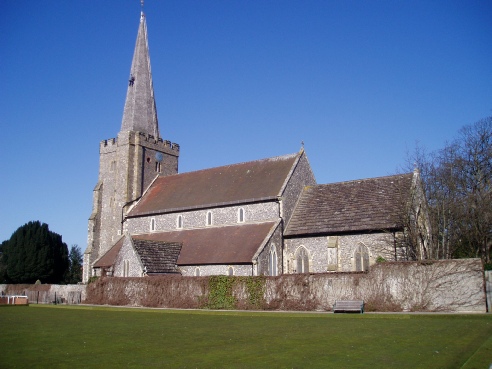



The Parish Church of St George the Martyr, Waterlooville

123. St Andrew, West Tarring
This lovely church with its fine 16th century spire, mostly dates from the 13th century Early English period and is constructed in flint and stone. Situated in the northern outskirts of Worthing it is surrounded by a very large churchyard where it is claimed Thomas Becket planted fig trees.
Entrance is via the Victorian north porch which contains boards listing the last testament of John Seldon a local Tudor benefactor. Inside, the chancel is separated from the nave by a 15th century screen surmounted by a row of large spikes. The east window commemorates J T Longman, a Victorian benefactor whilst the north east window is a memorial to James Henty a local farmer who emigrated to Australia in 1829 and founded the Merino sheep farming industry.
On the north wall is a 16th century brass commemorating a lawyer John Seldon whilst four modern banners depict the Evangelists. Other chancel glass show various saints such as Augustine, Ethelbert, Wilfred, Paul, Peter, Sergius Paullus and Cornelius. In the choir area note the six misere seats with fine carvings on the underside. The High Altar and altar rails are Jacobean but the remaining church furnishing such as the pulpit, pews, font and lectern are Victorian.
On the south wall of the aisle is a Royal Coat of Arms commemorating the Coronation of Queen Elizabeth II in 1953. A window at the west end of the south aisle depicts St Richard, Bishop of Chichester, who when denied his see between 1245-
But the most outstanding feature of the church dates from the restoration project of the rector, Dr Henry Bailey, in 1884-
The tower houses a peal of six bells and in the belfry area a collection of old musical instruments are on display. The beautifully maintained churchyard contains many old tombs and gravestones, the earliest being that of John Parson dated 1633. The lychgate was built as a memorial to the men who fell in the First World War.
John Symonds
Country Churches
Festival Edition 2010
